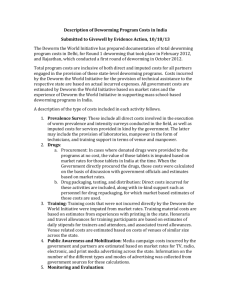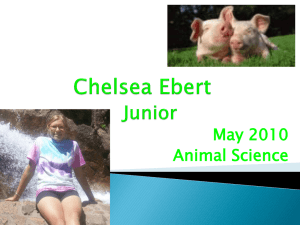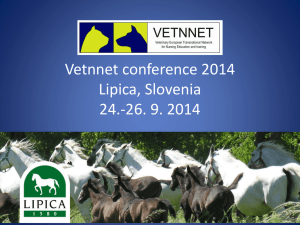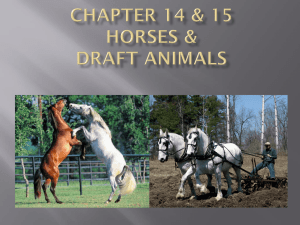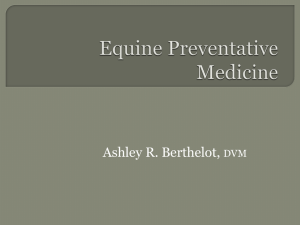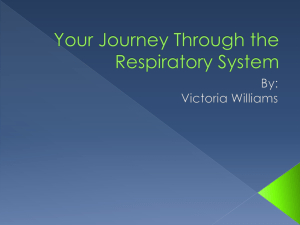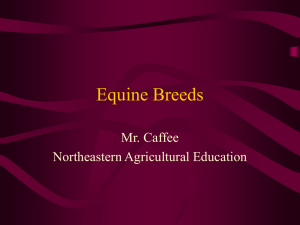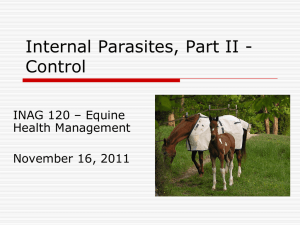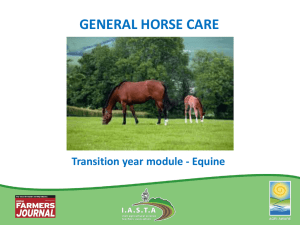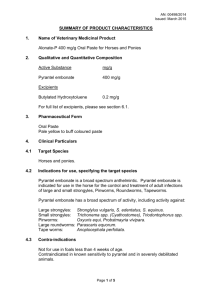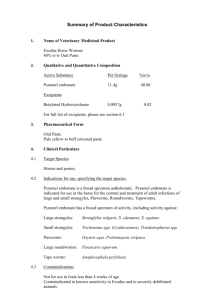Parasites-and-Deworm.. - The University of Tennessee College of
advertisement
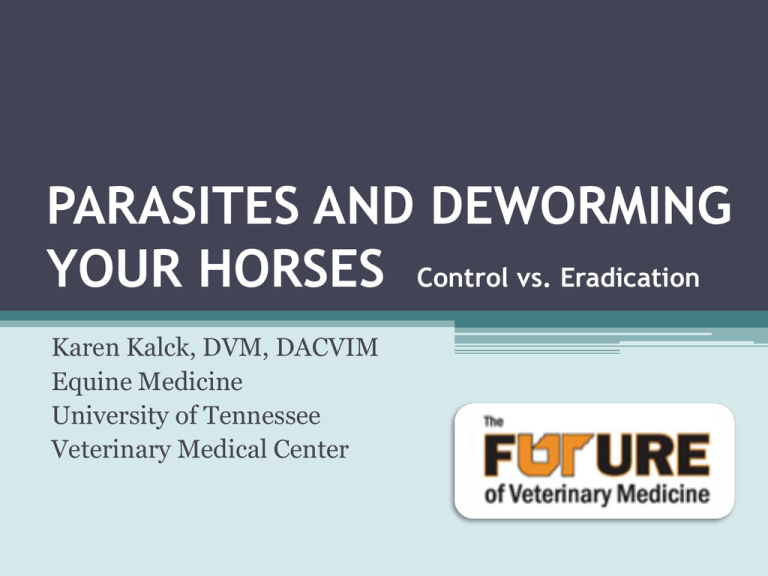
PARASITES AND DEWORMING YOUR HORSES Control vs. Eradication Karen Kalck, DVM, DACVIM Equine Medicine University of Tennessee Veterinary Medical Center PLAN • • • • • • Introduction Signs of parasitism Types of parasites Dewormers Diagnostics Designing a deworming program QUESTIONS 1. Raise your hand if you deworm your horse(s) every 2-3 months? 2. Every 4-6 months? 3. Once per year? 4. Whenever you remember to? COMMONLY ASKED QUESTIONS • • • • • • What type of wormer should I use? When should I worm my horse? Should I rotate my wormers each time? Should I use the same wormer all year long? How often should I worm and when? What are fecal egg counts and do I need to have these done? • How effective are feed through wormers? • My horse is rubbing it's tail, is this because of worms? COMMON PRACTICES • Deworm 4 times per year • Deworm 2 times per year, once after the first frost and once after the first hay cutting • Deworm all year with the same dewormer • Rotate your dewormer each time • Only deworm if your horse is thin and not putting on weight PARASITES vs. BACTERIA • No replication of numbers within the host • Life cycle • No immunity to parasites SIGNS OF PARASITISM • • • • • None Lethargy Loss of appetite Dull, rough haircoat Tail rubbing and hair loss • Loss of condition/weight • Slow growth in young horses • Pot belly • Coughing, nasal discharge • Diarrhea • Colic • Death TYPES OF PARASITES Large strongyles Small strongyles Roundworms Tapeworms Pinworms Lungworms Bots Strongyloides Large Strongyles Roundworms (Ascarids) Pinworms Small Strongyles Tapeworm LIFECYCLE Eggs • Manure of infected horse • Ground Grazing eggs/larvae swallowed • Immature worms Larvae • Stomach/intestines Larvae migrate out of intestines, into other tissues, and then return to intestine Adults • Mature worms passed in feces STRONGYLES • • • • Also known as bloodworms, red worms Can cause anemia Damage colon Mesenteric arteritis (large only) LARGE STRONGYLES SMALL STRONGYLES ROUNDWORMS • • • • • • Ascarids Young horses (<2 years) Large up to 15 inches in length! Do not suck blood Small intestinal obstruction Can migrate through the lung, causing damage and pneumonia TAPEWORMS • Affect the last part of the small intestine and cecum • Can cause ileal impactions • Eggs often not found in the feces PINWORMS • Females deposit eggs around anus in a “cementlike” mixture • This dries and cracks, causing irritation • “Rat-tail” appearance BOTS • Not worms, but fly larvae • Female flies lay eggs on horse legs • Horse ingests eggs • Larvae hatch and migrate to the stomach DIAGNOSTICS - Collection • Collect fresh feces in ziplock bag • Label with horse name and date • Send/take to veterinary laboratory • Herd Collect individual samples on same day DIAGNOSTICS • Fecal float ▫ Good screening test for all parasites ▫ Does not quantify • Fecal egg count (FEC) ▫ Not to be used for screening ▫ Will quantify numbers of eggs per gram of feces ▫ Only for strongyles and roundworms CONTROL VS. ERADICATION • Must encourage anthelmintic-sensitive worms in population • Do not want to become outnumbered by resistant worms GOAL = CONTROL • • • • • Keep FEC low Reduce transmission Reduce the development of drug resistance Have happy, healthy horses Kill adult parasites NO!!! DEWORMERS Ivermectin • Zimectrin • Equimax • Eqvalan • Ivercare • Rotation 1 Pyrantel • Strongid T pamoate • Rotation 2 • Quest plus Praziquantel • Zimectrin gold • Equimax Moxidectin • Quest Fenbendazole Oxibendazole • Anthelcide • Panacur • Safe-guard DEWORMERS Strongyles TapeRound- Pinworms worms worms Ivermectin / Moxidectin X Pyrantel pamoate X X X Oxibendazole X X X X X Praziquantel Fenbendazole X X X Bots X DAILY DEWORMER • • • • • Pyrantel tartrate (Strongid C) Does not resolve existing infections Not effective against tapeworms or bots Resistance! Only appropriate in very specific situations DESIGNING A DEWORMING PROGRAM • Do not deworm all horses every 8 weeks! ▫ High levels of drug resistance ▫ Biology of parasites has changed ▫ Different worm demographics from horse to horse DESIGNING A DEWORMING PROGRAM • New recommendations – strategic deworming ▫ Treat some horses more and others less ▫ Involves FEC ▫ Advantages Fewer deworming treatments Less drug resistance Better worm control POSSIBLE DEWORMING PLAN • First treatment in September • Last treatment in March • No further deworming until fall unless there is a very cool, wet summer POSSIBLE DEWORMING PLAN • Determine which anthelmintics are working in the herd • September Egg counts on all horses • Categorize horses’ contaminative potential ▫ <200 epg = low contaminators ▫ 200- 500 epg = moderate contaminators ▫ > 500 = high contaminators HYPOTHETICAL DISTRIBUTION OF STRONGYLE EGG COUNTS IN A HORSE HERD MODERATE (30%) NUMBER OF HORSES LOW (50%) FECAL EGG COUNT (per gram of feces) HIGH (20%) LOW CONTAMINATORS (< 200 epg) • September Treat with Ivermectin-Praziquantel OR • March Treat with Moxidectin-Praziquantel MODERATE CONTAMINATORS (200-500 epg) • September Treat with Ivermectin-Praziquantel OR • November Treat with oxibendazole and/or pyrantel (together) + • March Treat with Moxidectin-Praziquantel HIGH CONTAMINATORS (> 500 epg) • September Treat with Ivermectin-Praziquantel OR • November Treat with oxibendazole and/or pyrantel (together) + • December Treat with Moxidectin • March Treat with Moxidectin-Praziquantel • DEWORMING: Strategic vs. Every 2 months Classification # of horses Number of doses/year Subtotal Low 10 2 20 Moderate 6 3 18 High 4 4 16 Every 2 mos. 20 6 120 Grand total 54 120 DEWORMING IN FOALS/WEANLINGS • Start at 2 months of age • Deworm monthly • Alternate pyrantel and ivermectin • At 8 and 12 months give a product with praziquantel as well OR ENVIRONMENTAL CONTROL • Moisture ▫ Strongyle transmission occurs almost exclusively on pasture ▫ Stall and dry-lots are negligible • Season (in TN) ▫ Summer lowest pasture infectivity ▫ Winter cool enough to promote larval persistence ENVIRONMENTAL CONTROL • • • • • Manure management Pasture rotation and management Avoid over-stocking Group horses by age Feeders EQUINE WELLNESS PROGRAM UT Equine Hospital and Field Services • Comprehensive health care program for horses ▫ Pleasure horse ▫ Performance horse • Yearly health care needs in one package • Packages are a 20% discount from individual pricing • Eligible for additional discounts and benefits • Sign-up beginning March 12th, 2011! HORSE OWNERS CONFERENCE • March 12th, 2011 @ 8 am • At UT – Hollingsworth auditorium • Topics ▫ ▫ ▫ ▫ ▫ ▫ Wellness program Small pasture management Fescue toxicosis Foot care and diseases Use of common medications in horses Lameness examinations • $28/person ($15 for additional family members) • www.vet.utk.edu/continuing _ed UTVMC OPEN HOUSE • Saturday April 16, 2011 from 9 am – 4 pm • Educational day for families ▫ ▫ ▫ ▫ ▫ ▫ Teddy Bear Clinic Canine Parade of Breeds Equine Parade of Breeds – including Amigo! Farm Animals Wildlife and Exotic Animals Physical Therapy for Animals • www.vet.utk.edu/openhouse QUESTIONS?? • Thank you to Dr. Sharon Patton for providing information and pictures


